Copyright
To obtain a copy of this publication or an alternate format (Braille, large print, etc.), please fill out the Publication Request form or contact:
Web Services Centre
Innovation, Science and Economic Development Canada
C.D. Howe Building
235 Queen Street
Ottawa, ON K1A 0H5
Canada
Telephone (toll-free in Canada): 1-800-328-6189
Telephone (Ottawa): 613-954-5031
TTY (for hearing-impaired): 1-866-694-8389
Business hours: 8:30 a.m. to 5:00 p.m. (Eastern Time)
Email: ISED@canada.ca
Permission to Reproduce
Except as otherwise specifically noted, the information in this publication may be reproduced, in part or in whole and by any means, without charge or further permission from Industry Canada, provided that due diligence is exercised in ensuring the accuracy of the information reproduced; that the Department of Industry is identified as the source institution; and that the reproduction is not represented as an official version of the information reproduced, nor as having been made in affiliation with, or with the endorsement of, the Department of Industry.
For permission to reproduce the information in this publication for commercial purposes, please fill out the Application for Crown Copyright Clearance or contact the Web Services Centre (see contact information above).
© Her Majesty the Queen in Right of Canada,
as represented by the Minister of Industry, 2016
Cat. No. Iu186-1E-PDF
ISSN 1718-3456
Aussi offert en français sous le titre Principales statistiques relatives aux petites entreprises – Juin 2016
PDF Version
Key Small Business Statistics — June 2016
923 KB, 36 pages
Table of contents
- List of figures
- List of tables
- Foreword
- Highlights
- 1. Number of businesses
- 2. Employment
- 3. Growth
- 4. Financing
- 5. Innovation
- 6. Exports
- 7. Contribution to Gross Domestic Product
- 8. Business owner characteristics
- 9. Concluding remarks
List of figures
- Figure 2.1-1: Share of Total Private Employment by Size of Business, 2015
- Figure 2.2-1: Percentage of Private Net Employment Change by Business Size, 2005–2015
- Figure 2.2-2: Contribution to Net Change in Private Employment by Business Size, 2005–2015
- Figure 2.3-1: Births and Deaths of SMEs, 2013
- Figure 3.1-1: Percentage of High-Growth Firms by Industry, Based upon Revenue and Employment Growth, 2010–2013
- Figure 3.1-2: Gazelles as a Proportion of all Enterprises with at Least 10 Employees, Based upon Employment and Revenue Growth, 2011–2013
- Figure 4.1-1: Financing Instruments Used by Start-Up SMEs
- Figure 4.1-2: Financing Instruments Used by SMEs for Business Acquisitions
- Figure 5.1-1: Percentage of Total Expenditures ($ billions) on R&D by Business Size, 2011–2013
- Figure 5.1-2: Percentage of SMEs Innovating within the Last Three Years by Industrial Sector, 2012–2014
- Figure 6.1-1: Proportion of SMEs that Exported Goods and Services in 2014
- Figure 6.1-2: Proportion of Innovating and Non-Innovating SMEs that Exported in 2014
- Figure 7.1-1: Small Businesses' Contribution to GDP by Province, 2014
- Figure 8.1-1: SME Ownership by Gender, 2014
- Figure 8.1-2: Business Ownership by Gender and Industries, 2014
- Figure 8.2-1: Percentage of SME Owners by Age and Business Size, 2014
- Figure 8.2-2: Percentage of SME Owners by Years of Experience and Business Size, 2014
- Figure 8.2-3: Highest Level of Education Attained by SME Owners, 2014
List of tables
- Table 1.1-1: Total Number of Employer Businesses by Size and Number of Small and Medium-Sized Businesses per 1,000 Provincial Population, December 2015
- Table 1.1-2: Number of Employer Businesses by Sector and Firm Size (number of employees), December 2015
- Table 1.1-3: Number of Employer Businesses by Sector and Number of Employees, December 2015
- Table 2.1-1: Total Private Employment by Province and Establishment Size, 2015
- Table 2.1-2: Total Private Employment by Industrial Sector and Establishment Size, 2015
- Table 2.3-1: Business Insolvencies by Industry, 2014
- Table 4.1-1: External Financing Request Rate, 2014
- Table 4.1-2: SME Financing Authorized in 2014
- Table 6.1-1: Export Destinations of SMEs by Business Size, 2014
- Table 6.1-2: Export Destinations of SMEs by Industrial Sector, 2014
Foreword
Key Small Business Statistics provides statistical data on the business sector in Canada, focusing on small and medium-sized enterprises (SMEs). This edition contains data on the following questions:
- How many SMEs are there in Canada?
- How many people work for SMEs?
- How many jobs do SMEs create?
- How many businesses appear and disappear each year?
- What is the share of high-growth firms?
- What types of financing do SMEs use?
- How much do SMEs innovate?
- How do SMEs contribute to Canada's exports?
- How do SMEs contribute to Canada's gross domestic product?
- What is the number of female SME entrepreneurs?
- What are the age, experience and education levels of SME owners?
In this publication, the definition of what constitutes a "business" or an "enterprise" may vary slightly according to the statistical sources used. Below is a list of those sources and links to the definitions that they use:
- Business Register;
- Survey on Financing and Growth of Small and Medium Enterprises, 2014;
- Entrepreneurship Indicators Database;
- Labor Force Survey: and CANSIM Table 282-0075;
- Industrial Research and Development;
- Office of the Superintendent of Bankruptcy Canada; and
- British Columbia's Statistical Service, Small Business Profile, 2015 (PDF version, 2.3 MB, 34 pages).
Innovation, Science and Economic Development Canada (ISED) defines a business based upon the number of paid employees. For this reason, self-employed and "indeterminate" businesses are generally not included in the present publication as they do not have paid employees.Footnote 1
Accordingly, this publication defines an SME as a business establishment with 1–499 paid employees, more specifically:
- A small business has 1 to 99 paid employees.Footnote 2
- A medium-sized business has 100 to 499 paid employees.
- A large business has 500 or more paid employees.
The following are other definitions used in this publication:
- Start-up:
- A business that is two years old or younger.
- High-growth firm (HGF):
- A business with an average annualized growth rate of greater than20 percent, over a three-year period, and with 10 or more employees at the beginning of the period. HGF growth can be recorded in terms of revenue or employment (number of employees).
Notes on data and statistics:
- Many statistics on self-employment are no longer part of Key Small Business Statistics.
- In this report, numbers of industries differ based upon the survey source. In particular, the Survey on Financing and Growth of Small and Medium Enterprises covers fewer industries than the Labour Force Survey and the Business Register. Moreover, the Survey on Financing and Growth of Small and Medium Enterprises aggregates some industries together. As a result, some industry names will also differ.
Highlights
Number of businesses
- As of December 2015, the Canadian economy totalled 1.17 million employer businesses. Of these, 1.14 million (97.9 percent) were small businesses, 21,415 (1.8 percent) were medium-sized businesses and 2,933 (0.3 percent) were large businesses.
- In 2013, the total number of SME births was 78,430, compared with 83,240 deaths, which resulted in a net decrease of 4,810 businesses.
Employment
- As of 2015, small businesses employed over 8.2 million individuals in Canada, or 70.5 percent of the total private labour force. By comparison, medium-sized businesses accounted for 19.8 percent (2.3 million individuals) and large businesses accounted for 9.7 percent (1.1 million individuals) of the private sector workforce.
- Small businesses were responsible for the vast majority (87.7 percent) of net employment changeFootnote 3 between 2005 and 2015 (1.2 million jobs), compared with 7.7 percent for medium-sized businesses and 4.6 percent for large businesses.
High-growth firms
- High-growth firms are present in every economic sector and are not just concentrated in knowledge-based industries. In terms of employment, the highest concentrations of HGFs in Canada during the 2011–2013 period were in construction (5.5 percent); administrative and support services (5.5 percent); and transportation and warehousing (5.0 percent).
Financing
- In 2014, 51.3 percent of SMEs sought external financing, compared with 48.7 percent that did not request external financing.
- Lacking both a credit history and the collateral needed to secure a loan, over 80 percent of start-ups used personal financing to finance their new businesses.
Innovation
- Between 2011 and 2013, small businesses accounted for 27 percent of total research and development expenditures, spending $13.0 billion over the period.
- In 2014, the highest percentages of SMEs that innovated were found in manufacturing (61.5 percent), wholesale trade (50.5 percent) and professional, scientific and technical services (45.0 percent).
Exports
- In 2013, Canada exported goods totalling $420 billion, of which $106 billion (25.2 percent) was exported by SMEs.
- In 2014, 73,000 SMEs (11.8 percent) exported goods and services.
Small business contribution to GDP
- In 2014, small businesses contributed an average of 30 percent to the gross domestic product (GDP) of their province.
- Small businesses in British Columbia and Alberta contributed the highest share to their provincial GDP at 33 percent and 32 percent respectively.
- Small businesses in Saskatchewan and Quebec contributed 30 percent to their provincial GDP.
Female entrepreneurs
- In 2014, 15.7 percent of SMEs were majority owned by women and 19.7 percent were equally owned by women and men.
- SMEs owned by female entrepreneurs are most common in information, administration, health care and recreation; and other services (24.1 percent and 23.0 percent respectively).
Business owner characteristics
- In 2014, the highest percentage of SME owners was in the 50–64 years of age group (47.4 percent for small businesses and 51.0 percent for medium-sized businesses).
- More than 60 percent of medium-sized business owners have a bachelor's or a master's degree,compared with 38 percent for small businesses.
1. Number of Businesses
1.1 How many SMEs are there in Canada?
As of December 2015, there were 1.17 million employer businesses in Canada, as shown in Table 1.1-1. Of these, 1.14 million (97.9 percent) businesses were small businesses, 21,415 (1.8 percent) were medium-sized businesses and 2,933 (0.3 percent) were large enterprises.
| Provinces/ Territories | Employer Businesses | Number of SMEs per 1,000 Population (aged 15+ years) | |||
|---|---|---|---|---|---|
| Small (1–99) | Medium (100–499) | Large (500+) | Total | ||
| Source: Statistics Canada, Business Register, December 2015. | |||||
| Newfoundland and Labrador | 17,174 | 307 | 45 | 17,526 | 39.1 |
| Prince Edward Island | 5,838 | 83 | 14 | 5,935 | 48.7 |
| Nova Scotia | 29,298 | 556 | 68 | 29,922 | 37.3 |
| New Brunswick | 25,002 | 443 | 64 | 25,509 | 40.0 |
| Quebec | 235,075 | 4,301 | 590 | 239,966 | 34.7 |
| Ontario | 407,175 | 8,437 | 1,189 | 416,801 | 36.3 |
| Manitoba | 37,776 | 829 | 107 | 38,712 | 37.3 |
| Saskatchewan | 40,453 | 644 | 88 | 41,185 | 45.5 |
| Alberta | 165,792 | 3,076 | 437 | 169,305 | 50.0 |
| British Columbia | 176,014 | 2,623 | 329 | 178,966 | 45.2 |
| Yukon | 1,723 | 34 | 0 | 1,757 | 57.3 |
| Northwest Territories | 1,606 | 51 | 1 | 1,658 | 48.5 |
| Nunavut | 704 | 31 | 1 | 736 | 29.6 |
| Canada | 1,143,630 | 21,415 | 2,933 | 1,167,978 | 39.2 |
| Percentage | 97.9 | 1.8 | 0.3 | 100.0 | |
More than half of Canada's small employer businesses are concentrated in Ontario and Quebec (407,175 and 235,075 respectively). Western Canada has a robust and growing small business community led by British Columbia, which had 176,014 small businesses as of December 2015. Among the Atlantic provinces, Nova Scotia is home to the greatest number of small businesses, totalling 29,298.
In terms of the number of SMEs relative to the population (aged 15 years and above), Alberta and Prince Edward Island have more SMEs than the other provinces, with ratios of 50.0 and 48.7 per 1,000 population respectively. Ontario and Quebec have the lowest values in this category at 36.3 and 34.7 per 1,000 population respectively.
While it is well understood that small businesses make up nearly the entirety of all firms, just how small these firms are is not common knowledge. Of the 1,167,978 employer businesses active in Canada, micro-enterprises (firms with 1 to 4 employees) constitute 54.1 percent of all private employers, which is the largest SME group. If the groups of employer businesses with 5 to 9 and 10 to 19 employees are included, they account for 86.2 percent of employer businesses (Table 1.1-2).
| Number of Employees | Cumulative Percentage of Employer Businesses | Locations Counts with Employees | ||
|---|---|---|---|---|
| Total | Goods-Producing Sector | Service-Producing Sector | ||
| Note: By definition, the goods-producing sector consists of manufacturing; construction; and forestry, fishing, mining, quarrying, and oil and gas. The service-producing sector consists of wholesale and retail trade; accommodation and food services; professional, scientific and technical services; finance, insurance, real estate and leasing; health care and social assistance; business, building and other support services; information, culture and recreation; transportation and warehousing; other services; and public administration. Source: Statistics Canada, Business Register, December 2015. | ||||
| 1–4 | 54.1 | 632,460 | 143,481 | 488,979 |
| 5–9 | 73.5 | 226,412 | 47,912 | 178,500 |
| 10–19 | 86.2 | 147,823 | 27,415 | 120,408 |
| 20–49 | 95.1 | 103,607 | 19,547 | 84,060 |
| 50–99 | 97.9 | 33,328 | 7,185 | 26,143 |
| Small (1–99) | 97.9 | 1,143,630 | 245,540 | 898,090 |
| 100–199 | 99.1 | 14,284 | 3,554 | 10,730 |
| 200–499 | 99.7 | 7,131 | 1,788 | 5,343 |
| 500+ | 100.0 | 2,933 | 569 | 2,364 |
| Total | 1,167,978 | 251,451 | 916,527 | |
The majority of Canadian businesses are service oriented. Of all employer businesses, 916,527 (78.5 percent) operate in the service-producing sector, compared with 251,451 (21.5 percent) in the goods-producing sector.
Table 1.1-3 presents the distribution of employer businesses by size in each industry. Over half of the 1.14 million small businesses are concentrated in five industries: retail trade (12.5 percent), construction (12.2 percent), professional, scientific and technical services (12.0 percent), other services (9.6 percent) and health care and social assistance (9.2 percent). The distribution of medium-sized businesses is different, with nearly half concentrated across manufacturing (14.6 percent), retail trade (13.5 percent), health care and social assistance (10.3 percent) and administrative and support, waste management and remediation services (7.5 percent).
| Industrial Sector | Employer Businesses | ||||||||||
|---|---|---|---|---|---|---|---|---|---|---|---|
| Total | 1–4 | 5–9 | 10–19 | 20–49 | 50–99 | Small (1–99) | 100–199 | 200–499 | Medium (100–499) | Large (500+) | |
| Source: Statistics Canada, Business Register, December 2015. | |||||||||||
| Agriculture, forestry, fishing and hunting | 47,397 | 33,251 | 7,790 | 3,606 | 1,951 | 523 | 47,121 | 204 | 61 | 265 | 11 |
| Mining, quarrying, and oil and gas extraction | 10,446 | 6,238 | 1,273 | 1,106 | 940 | 425 | 9,982 | 242 | 136 | 378 | 86 |
| Utilities | 1,460 | 523 | 236 | 187 | 236 | 133 | 1,315 | 62 | 45 | 107 | 38 |
| Construction | 141,246 | 85,701 | 28,494 | 14,314 | 8,578 | 2,546 | 139,633 | 1,059 | 412 | 1,471 | 142 |
| Manufacturing | 50,902 | 17,768 | 10,119 | 8,202 | 7,842 | 3,558 | 47,489 | 1,987 | 1,134 | 3,121 | 292 |
| Wholesale trade | 60,184 | 25,458 | 13,467 | 10,671 | 7,339 | 2,133 | 59,068 | 741 | 315 | 1,056 | 60 |
| Retail trade | 145,566 | 53,060 | 41,987 | 26,914 | 15,049 | 5,555 | 142,565 | 2,115 | 779 | 2,894 | 107 |
| Transportation and warehousing | 63,629 | 44,399 | 7,493 | 5,065 | 4,075 | 1,405 | 62,437 | 712 | 351 | 1,063 | 129 |
| Information and cultural industries | 15,650 | 8,049 | 2,713 | 1,943 | 1,727 | 638 | 15,070 | 325 | 193 | 518 | 62 |
| Finance and insurance | 42,762 | 20,853 | 6,589 | 5,857 | 7,531 | 1,003 | 41,833 | 444 | 325 | 769 | 160 |
| Real estate and rental and leasing | 49,068 | 33,990 | 7,365 | 4,194 | 2,392 | 694 | 48,635 | 263 | 122 | 385 | 48 |
| Professional, scientific and technical services | 138,375 | 103,809 | 16,342 | 9,365 | 5,799 | 1,845 | 137,160 | 758 | 343 | 1,101 | 114 |
| Management of companies and enterprises | 11,816 | 6,586 | 1,588 | 1,179 | 1,111 | 571 | 11,035 | 352 | 244 | 596 | 185 |
| Administrative and support, waste management and remediation services | 52,800 | 27,466 | 10,778 | 6,538 | 4,449 | 1,762 | 50,993 | 976 | 634 | 1,610 | 197 |
| Educational services | 13,487 | 5,848 | 2,507 | 1,923 | 1,652 | 626 | 12,556 | 260 | 237 | 497 | 434 |
| Health care and social assistance | 107,423 | 60,206 | 20,621 | 13,923 | 7,546 | 2,567 | 104,863 | 1,442 | 758 | 2,200 | 360 |
| Arts, entertainment and recreation | 17,567 | 8,305 | 3,313 | 2,390 | 2,228 | 737 | 16,973 | 346 | 172 | 518 | 76 |
| Accommodation and food services | 79,693 | 19,347 | 18,960 | 18,313 | 17,053 | 4,721 | 78,394 | 950 | 292 | 1,242 | 57 |
| Other services (except public administration) | 110,233 | 69,795 | 23,400 | 10,768 | 4,579 | 1,068 | 109,610 | 424 | 156 | 580 | 43 |
| Public administration | 8,274 | 1,808 | 1,377 | 1,365 | 1,530 | 818 | 6,898 | 622 | 422 | 1,044 | 332 |
| Total | 1,167,978 | 632,460 | 226,412 | 147,823 | 103,607 | 33,328 | 1,143,630 | 14,284 | 7,131 | 21,415 | 2,933 |
2. Employment
2.1 How many people work for SMEs?
In 2015, the Canadian private sectorFootnote 4 employed over 11.6 million people. As shown in Figure 2.1-1, the majority of these employees worked for small businesses, constituting 70.5 percent (8.2 million) of private sector employment. By comparison, medium-sized businesses employed 19.8 percent (2.3 million) and large businesses employed 9.7 percent (1.1 million) of the private sector workforce. In total, SMEs employed 90.3 percent (10.5 million) of the private sector workforce, highlighting the important role SMEs play in employing Canadians.
Figure 2.1-1: Share of Total Private Employment by Size of Business, 2015
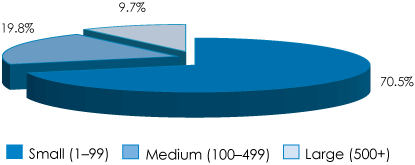
Sources: Statistics Canada, Labour Force Survey (LFS); and Innovation, Science and Economic Development Canada calculations.
Table 2.1-1 indicates the vital role SMEs play in employing Canadians across the country. The highest share of total employment in SMEs was found in British Columbia (93.6 percent), followed closely by Saskatchewan (93.1 percent). While the lowest share of total employment in SMEs occurred in Ontario and Alberta, these two provinces still employed a staggering 87.3 percent and 91.2 percent, respectively, of the private sector workforce. Such variations are due to the structure of provincial economies. For example, Ontario's economy has many large firms in the manufacturing sector, whereas British Columbia's economy is structured around small businesses.
| Province | Establishment Size (thousand employees) | Percentage of SME Employment | ||||
|---|---|---|---|---|---|---|
| Small (1–99) | Medium (100–499) | Employment SMEs | Large (500+) | Total Employment | ||
| Sources: Statistics Canada, Labour Force Survey (LFS); and Innovation, Science and Economic Development Canada calculations. | ||||||
| Newfoundland and Labrador | 114.8 | 25.6 | 140.4 | 12.9 | 153.3 | 91.6 |
| Prince Edward Island | 32.8 | 5.8 | 38.6 | 3.0 | 41.6 | 92.7 |
| Nova Scotia | 206.2 | 51.5 | 257.6 | 20.8 | 278.4 | 92.5 |
| New Brunswick | 158.7 | 46.2 | 204.9 | 17.9 | 222.8 | 92.0 |
| Quebec | 1,887.7 | 550.0 | 2,437.8 | 212.6 | 2,650.4 | 92.0 |
| Ontario | 3,015.4 | 946.0 | 3,961.4 | 576.5 | 4,538.0 | 87.3 |
| Manitoba | 275.6 | 75.1 | 350.7 | 36.2 | 386.9 | 90.6 |
| Saskatchewan | 251.2 | 55.0 | 306.2 | 22.8 | 329.0 | 93.1 |
| Alberta | 1,127.0 | 263.0 | 1,390.0 | 133.3 | 1,523.4 | 91.2 |
| British Columbia | 1,098.6 | 274.7 | 1,373.3 | 94.0 | 1,467.3 | 93.6 |
| Canada | 8,168.0 | 2,292.9 | 10,460.9 | 1,130.0 | 11,590.9 | 90.3 |
The distribution of employment by size of business varies across industries. As shown in Table 2.1-2, small and medium-sized businesses account for over 90 percent of employment in seven industries: agriculture (98.8 percent), other services (98.6 percent), accommodation and food services (98.0 percent), wholesale and retail trade (97.1 percent), construction (96.0 percent), business, building and other support services (93.4 percent) and professional, scientific and technical services (90.7 percent). In all industries, at least 70 percent of the workforce is employed by small and medium-sized businesses.
| Industry | Establishment Size (thousand employees) | Percentage of SME Employment | ||||||
|---|---|---|---|---|---|---|---|---|
| 1–19 | 20–99 | Small (1–99) | Medium (100–499) | Large (500+) | Total Employment | |||
| Sources: Statistics Canada, Labour Force Survey (LFS); and Innovation, Science and Economic Development Canada calculations. | ||||||||
| Goods | Agriculture | 80.1 | 30.1 | 110.2 | 9.1 | 1.4 | 120.8 | 98.8 |
| Forestry, fishing, mining, quarrying, oil and gas | 75.7 | 87.6 | 163.3 | 80.2 | 77.5 | 320.9 | 75.9 | |
| Utilities | 3.8 | 6.7 | 10.5 | 6.1 | 6.4 | 23.0 | 72.2 | |
| Construction | 449.7 | 308.7 | 758.4 | 128.7 | 37.3 | 924.3 | 96.0 | |
| Manufacturing | 284.5 | 526.4 | 810.8 | 579.5 | 250.7 | 1,641.0 | 84.7 | |
| Services | Wholesale and retail trade | 941.9 | 1,020.0 | 1,961.9 | 427.5 | 70.2 | 2,459.6 | 97.1 |
| Transportation and warehousing | 149.2 | 201.3 | 350.5 | 140.8 | 84.7 | 576.1 | 85.3 | |
| Finance, insurance, real estate and leasing | 278.1 | 250.9 | 529.0 | 170.5 | 148.5 | 848.0 | 82.5 | |
| Professional, scientific and technical services | 322.5 | 296.4 | 618.9 | 196.1 | 84.0 | 899.1 | 90.7 | |
| Business, building and other support services | 251.9 | 159.7 | 411.6 | 102.5 | 36.4 | 550.5 | 93.4 | |
| Educational Services | 15.9 | 46.8 | 62.8 | 18.1 | 19.3 | 100.2 | 80.7 | |
| Health care and social assistance | 277.2 | 256.8 | 534.0 | 185.2 | 206.8 | 926.0 | 77.7 | |
| Information, culture and recreation | 146.5 | 167.5 | 313.9 | 126.0 | 76.4 | 516.3 | 85.2 | |
| Accommodation and food services | 521.7 | 491.8 | 1,013.5 | 83.3 | 22.5 | 1,119.3 | 98.0 | |
| Other services (except public administration) | 391.7 | 127.0 | 518.7 | 39.2 | 8.1 | 565.9 | 98.6 | |
| Goods-Producing Sector | 893.7 | 959.5 | 1,853.2 | 803.5 | 373.2 | 3,030.0 | 87.7 | |
| Service-Producing Sector | 3,296.6 | 3,018.2 | 6,314.8 | 1,489.3 | 756.8 | 8,560.9 | 91.2 | |
| All Industries | 4,190.3 | 3,977.7 | 8,168.0 | 2,292.9 | 1,130.0 | 11,590.9 | 90.3 | |
| Percentage of Total Employment | 36.2 | 34.3 | 70.5 | 19.8 | 9.7 | |||
In terms of the total number of employees, industries that had the largest number of employees working for small firms were, in order of magnitude, wholesale and retail trade (1.96 million), accommodation and food services (1.01 million), manufacturing (0.81 million) and construction (0.76 million). These industries alone accounted for 55.6 percent of all jobs in small businesses in Canada. Overall, industries in the goods-producing sector accounted for 26.1 percent of total employment and 22.7 percent of employment in small businesses. Agriculture has the largest proportion of businesses with 1–19 employees relative to total industry employment, employing 80,100 individuals out of a total of 120,800 employees (close to 70 percent).
http://www.ic.gc.ca/eic/site/061.nsf/eng/03022.html#q32.2 How many jobs do SMEs create?
Small businesses account for 97.9 percent of all firms in Canada and proportionally play a large role in net job creation. Figure 2.2-1 shows that the contribution to net employment change between 2005 and 2015 (1.2 million jobs) was 87.7 percent attributable to small businesses. Medium-sized and large businesses, which account for 1.8 percent and 0.3 percent of all firms, respectively, created just 7.7 percent and 4.6 percent of net new jobs over the same period.
Figure 2.2-1: Percentage of Private Net Employment Change by Business Size, 2005–2015
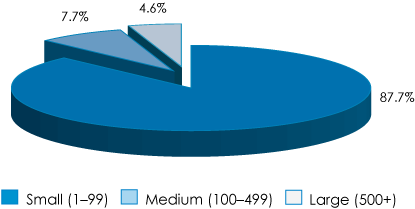
Sources: Statistics Canada, Labour Force Survey (LFS); and Innovation, Science and Economic Development Canada calculations.
Figure 2.2-2 illustrates the relative contributions of small, medium-sized and large businesses to the net change in total private employment over the period 2005–2015. The relative contribution varied by year, but small businesses consistently outperformed medium-sized and large businesses in terms of employment growth. During this period, small businesses' total employment increased by over 1.0 million employees, compared with 90,000 employees for medium-sized businesses and 53,000 employees for large businesses.
Figure 2.2-2: Contribution to Net Change in Private Employment by Business Size, 2005–2015
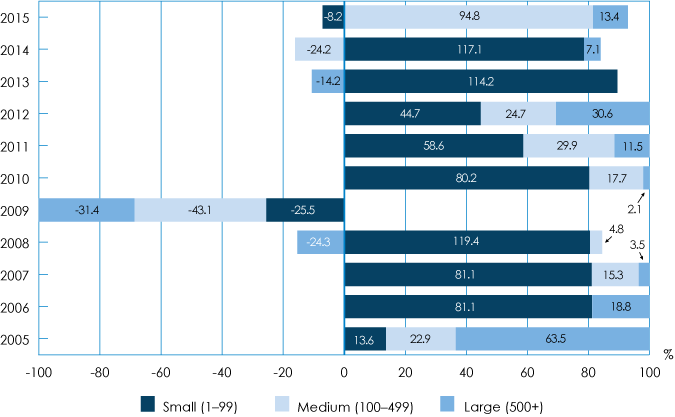
Sources: Statistics Canada, Labour Force Survey (LFS); and Innovation, Science and Economic Development Canada calculations.
Small businesses' contribution to the net change in private employment was highest in 2006 (182,600 jobs) and 2013 (172,100 jobs). In 2009, SME net job losses were over 219,300 owing to the harsh economic conditions associated with the financial crisis. In 2010, this trend changed with more than 847,400 net job gains in SMEs between 2010 and 2015.
http://www.ic.gc.ca/eic/site/061.nsf/eng/03022.html#q42.3 How many businesses appear and disappear each year?
Thousands of businesses enter and exit the marketplace throughout the year. Figure 2.3-1 shows how many SMEs appeared and disappeared in Canada in 2013. The greatest number of SME births (13,820) and deaths (12,590) occurred in professional, scientific and technical services, followed by construction (12,050 births and 11,900 deaths). Mining and oil and gas extraction had the fewest SME births and deaths (780 and 800 respectively). In 2013, the total number of SME births was 78,430, compared with 83,240 deaths, which resulted in a net decrease of 4,810 businesses.
Figure 2.3-1: Births and Deaths of SMEs, 2013

Source: Statistics Canada, Entrepreneurship Indicators Database.
Bankruptcy and insolvency statistics
Only a fraction of exiting enterprises declared bankruptcy. In 2014, 3,116 Canadian businesses filed for bankruptcy, compared with 3,187 in 2013. More detailed statistics on this subject are available on the Office of the Superintendent of Bankruptcy Canada website.
As indicated in Table 2.3-1, the greatest number of insolvency cases occurred within the accommodation and food services sector. This is to be expected as the industry is fiercely competitive and restaurants are one of the easiest businesses to start. Manufacturing firms were next in the number of insolvencies, highlighting the challenges facing this sector over the past decade.
| Industrial Sector | Number of insolvency cases per 1,000 businesses with and without employees |
|---|---|
| Sources: Office of the Superintendent of Bankruptcy Canada, 2014; and Innovation, Science and Economic Development Canada calculations. | |
| Agriculture, forestry, fishing and hunting | 0.4 |
| Mining, quarrying, and oil and gas extraction | 1.6 |
| Utilities | 3.0 |
| Construction | 2.0 |
| Manufacturing | 4.3 |
| Wholesale trade | 2.1 |
| Retail trade | 2.0 |
| Transportation and warehousing | 1.5 |
| Information and cultural industries | 1.5 |
| Finance and insurance | 0.5 |
| Real estate and rental and leasing | 0.2 |
| Professional, scientific and technical services | 0.7 |
| Management of companies and enterprises | 0.7 |
| Administrative and support, waste management and remediation services | 1.6 |
| Educational services | 1.6 |
| Health care and social assistance | 0.4 |
| Arts, entertainment and recreation | 1.5 |
| Accommodation and food services | 5.8 |
| Other services (except public administration) | 0.9 |
| Total | 1.3 |
3. Growth
3.1 What is the share of high-growth firms?
Firms that achieve high growth in a short period of time tend to make a large contribution in terms of employment and wealth creation. Although policy-makers tend to associate high-growth firms with innovative high-tech firms, the reality, as discussed below, is that they are found across all industrial sectors.
Figure 3.1-1 presents percentages of HGFs across different industries between 2010 and 2013 based upon revenue and employment. As illustrated, there are HGFs in every industry. In the goods-producing sector, the greatest proportions of HGFs are found in construction (11.7 percent) and manufacturing (11.0 percent). In the service-producing sector, industries with the highest share of HGFs occur in professional and technical services (11.6 percent), and transportation and warehousing (10.2 percent). Overall, the proportion of HGFs in terms of revenue is twice as high as the proportion of HGFs based upon employment (7.4 percent versus 3.4 percent respectively).
Figure 3.1-1: Percentage of High-Growth Firms by Industry, Based upon Revenue and Employment Growth, 2010–2013
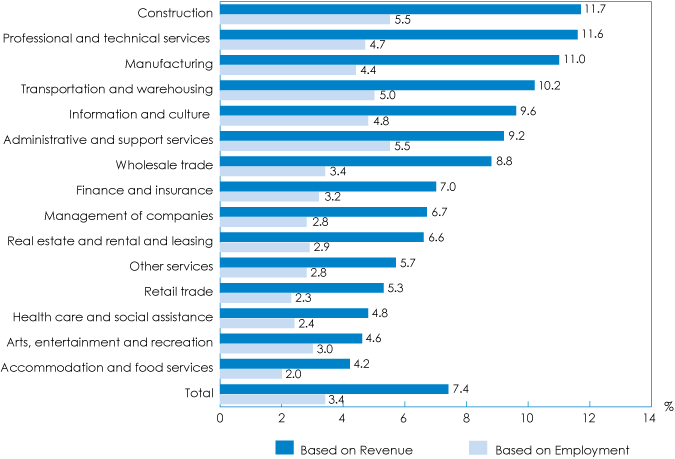
Source: Statistics Canada, Entrepreneurship Indicators Database.
Gazelles are HGFs that are four or five years old, have at least 10 employees and have average annualized growth of greater than 20 percent over a three-year period. Growth can be measured by the number of employees or by revenue. Figure 3.1-2 shows gazelles as a proportion of all businesses with at least 10 employees. Between 2011 and 2013, the share of gazelles based upon employment remained at 0.6 percent, which is approximately 2.6 times less than the share of gazelles based upon revenue, which changed from 1.7 percent in 2011 to 1.6 percent in 2013.
Figure 3.1-2: Gazelles as a Proportion of all Enterprises with at Least 10 Employees, Based upon Employment and Revenue Growth, 2011–2013

Note: Excludes agriculture, forestry, fishing and hunting (NAICS 11); mining and oil and gas extraction (NAICS 21); and utilities (NAICS 22).
Source: Statistics Canada, Entrepreneurship Indicators Database, 2015.
4. Financing
4.1 What types of financing do SMEs use?
Given their role in the economy, it is important that SMEs have access to the financing they need to grow and thrive. Insufficient access to financing can lead to liquidity shortages, stagnant growth and reduced market competitiveness. Firms rely on financing to pursue new innovations and expand into new markets. As such, the state of firms accessing financing is an important indicator of overall economic health. Table 4.1-1 summarizes data on SMEs seeking external financing. In 2014, 51.3 percent of SMEs sought external financing, compared with 48.7 percent that did not request external financing. The total authorized amount to SMEs in 2014 was over $53 billion (Table 4.1-2).
| Firm Size | Requested external financing | Did not request external financing | Reason for not requesting external financing (percentage of SMEs) | |||||
|---|---|---|---|---|---|---|---|---|
| Financing not required | Thought request would be turned down | Applying for financing too difficult or time consuming | Cost of financing too high | Unaware of financing sources available to the business | Other | |||
| Source: Statistics Canada, Survey on Financing and Growth of Small and Medium Enterprises, 2014. | ||||||||
| All SMEs (1–499) | 51.3 | 48.7 | 88.3 | 1.9 | 2.1 | 0.8 | 3.1 | 3.8 |
| Financing Type | Request rate (%) | Approval rate (%) | Total amount authorized ($ billions) | Percentage of total amount authorized |
|---|---|---|---|---|
| Source: Statistics Canada, Survey on Financing and Growth of Small and Medium Enterprises, 2014. | ||||
| Debt Financing | 28.1 | 82.1 | 28.0 | 52.3 |
| Trade Credit | 29.4 | 98.3 | 16.3 | 30.5 |
| Leasing | 7.9 | 98.2 | 4.6 | 8.6 |
| Government | 4.4 | 82.8 | 1.2 | 2.3 |
| Equity | 0.9 | n/a | 3.3 | 6.2 |
| Total | 51.3 | n/a | 53.5 | 100.0 |
SME financing can be broadly divided into formal and informal sources. Informal financing sources include owners' savings and personal loans taken out by owners. Formal financing comes from debt financing, lease financing, equity financing, trade credit and government grants.
Start-up SMEs often lack both a credit history and the collateral needed to secure a loan, which makes informal financing the most common source for new businesses. Over 80 percent of start-ups used personal financing, 45 percent used credit from financial institutions and 19 percent received trade credit from suppliers (Figure 4.1-1).
Figure 4.1-1: Financing Instruments Used by Start-Up SMEs

Note: Multiple responses were possible, so estimates will not add up to 100 percent.
Source: Statistics Canada, Survey on Financing and Growth of Small and Medium Enterprises, 2014.
Business acquisitions help secure market share, talent and revenue and serve as an important growth strategy. Financing business acquisitions is similar to financing start-up SMEs in general. As shown in Figure 4.1-2, the most common instrument for financing business acquisitions was credit from personal financing (71 percent), followed by credit from financial institutions (61 percent).
Figure 4.1-2: Financing Instruments Used by SMEs for Business Acquisitions
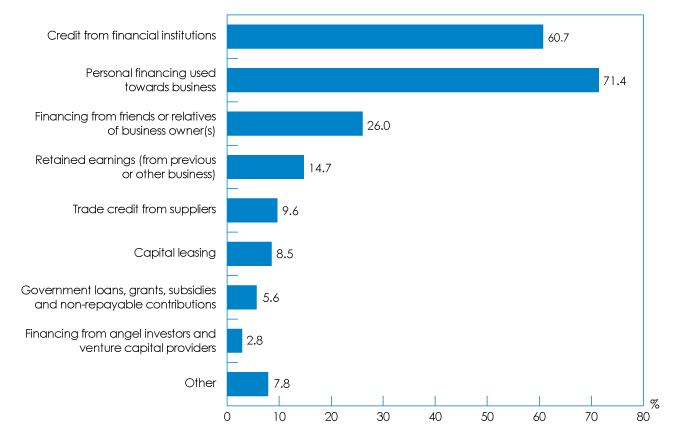
Note: Multiple responses were possible, so estimates will not add up to 100 percent.
Source: Statistics Canada, Survey on Financing and Growth of Small and Medium Enterprises, 2014.
5. Innovation
5.1 How much do SMEs innovate?
In a world with limited resources, the fastest way for SMEs to boost productivity and economic growth is to innovate. Innovation is often thought to be synonymous with high-technology inventions, but innovative business behaviour encompasses a broad range of practices, including technological inventions and operational optimizations, to turn creative ideas into innovations. The Survey on Financing and Growth of Small and Medium Enterprises, 2014 divides innovations into product, process, organizational and marketing categories.Footnote 5 Survey data show that over 41.7 percent of small businesses and 58.3 percent of medium-sized enterprises implemented at least one type of innovation.
The availability of resources to spend on research and development (R&D) is tied to the size of businesses. While large businesses make up approximately 0.3 percent of all employer businesses, Figure 5.1-1 shows that between 2011 and 2013 they accounted for over 50 percent of all R&D spending. Comparatively, despite representing 97.9 percent of all employer businesses, small businesses accounted for about 27 percent of total R&D spending. Medium-sized businesses, which make up 1.8 percent of employer businesses, accounted for about 18 percent of all R&D spending. It is particularly noteworthy that SME spending on R&D has been consistently declining over the course of the period 2011–2013.
Figure 5.1-1: Percentage of Total Expenditures ($ billions) on R&D by Business Size, 2011–2013
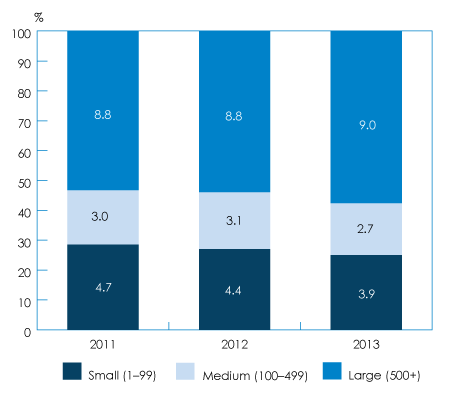
Sources: Statistics Canada, Industrial Research and Development, 2015; and Innovation, Science and Economic Development calculations.
Figure 5.1-2 shows the percentage of SMEs by industry that have innovated within the last three years. Innovation levels were highest in manufacturing (61.5 percent), wholesale trade (50.5 percent) and professional, scientific and technical services (45.0 percent). Transportation and warehousing, and construction have the lowest percentage of innovative businesses, with only 31.0 percent and 36.4 percent of businesses innovating, respectively, within the last three years.
Figure 5.1-2: Percentage of SMEs Innovating within the Last Three Years by Industrial Sector, 2012–2014
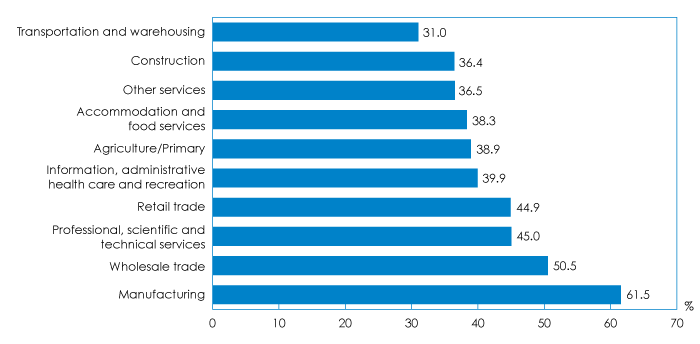
Source: Statistics Canada, Survey on Financing and Growth of Small and Medium Enterprises, 2014.
6. Exports
6.1 How do SMEs contribute to Canada's exports?
Exporting is vital to Canada's economy. It is a driver of economic growth and is strongly correlated with real gross domestic product growth. Furthermore, exporting can provide a strategically important means of growing a firm by expanding its market beyond the confines of Canada's relatively small domestic market. Canada's continued commitment to establishing trade agreements reflects this importance.
In 2013, Canada exported goods totalling $420 billion, of which $106 billion was exported by SMEs. More than 37,000 Canadian SMEs were active exporters of goods to a broad array of international destinations. While the majority (over 26,000) of these SMEs exported to only one country, a significant number exported to two and three to five countries (4,200 and 3,700 respectively).Footnote 6
Data from the Survey on Financing and Growth of Small and Medium Enterprises, 2014, which captures exports of both goods and services, show that 11.8 percent (73,000) of SMEs exported in 2014. The percentage of small businesses that export is less than half the percentage of medium-sized enterprises that export, revealing the important role that size plays in determining the propensity of firms to export (Figure 6.1-1).
Figure 6.1-1: Proportion of SMEs that Exported Goods and Services in 2014
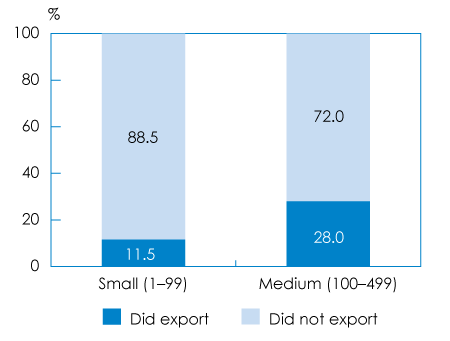
Sources: Statistics Canada, Survey on Financing and Growth of Small and Medium Enterprises, 2014; and Innovation, Science and Economic Development Canada calculations.
As illustrated in Figure 6.1-2, innovative SMEs tend to outperform non-innovators in terms of exports. This suggests that innovation and exports may be positively correlated, but further research is required to determine the role of product, process, organizational and marketing innovations in exporting.
Figure 6.1-2: Proportion of Innovating and Non-Innovating SMEs that Exported in 2014
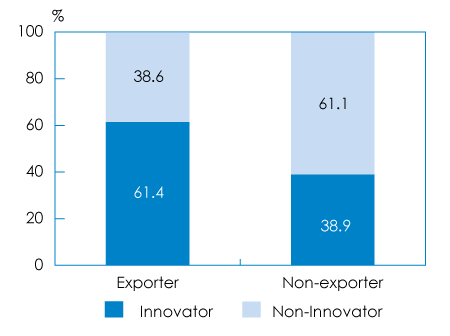
Sources: Statistics Canada, Survey on Financing and Growth of Small and Medium Enterprises, 2014; and Innovation, Science and Economic Development Canada calculations.
In terms of destinations in 2014, Table 6.1-1 indicates that the main destination for Canadian SME exports continues to be the United States, which accounted for 88.1 percent of total exports of small businesses and 96.2 percent of exports of medium-sized businesses. In 2014, national SMEs also actively exported to China and other Asian countries, which cumulatively accounted for over 25 percent of exports of small businesses and more than 40 percent of exports of medium-sized enterprises. Compared with medium-sized businesses, the percentage of small enterprises that export is lower in all destination categories except Europe, where the percentage of small and medium-sized exporters is almost identical (31.6 percent for small businesses versus 31.2 percent for medium-sized enterprises).
| Business Size (number of employees) | United States | Latin America | Europe | China | Other Asia | Other |
|---|---|---|---|---|---|---|
| Note: Multiple responses were possible, so estimates add up to more than 100 percent. Sources: Statistics Canada, Survey on Financing and Growth of Small and Medium Enterprises, 2014; and Innovation, Science and Economic Development Canada calculations. | ||||||
| All SMEs | 89.2% | 16.7% | 31.3% | 13.1% | 15.5% | 20.6% |
| 1–4 | 84.4% | 13.8% | 32.7% | 11.5% | 15.6% | 18.0% |
| 5–19 | 92.6% | 16.4% | 30.2% | 15.5% | 13.8% | 23.9% |
| 20–99 | 91.7% | 21.4% | 30.4% | 11.0% | 17.0% | 18.7% |
| Small (1–99) | 88.1% | 15.6% | 31.6% | 12.8% | 15.1% | 20.1% |
| Medium (100–499) | 96.2% | 26.5% | 31.2% | 17.7% | 24.1% | 27.7% |
Further evidence highlighting the centrality of the United States as a major export destination for SMEs is presented in Table 6.1-2. In particular, the United States is an especially important destination for manufacturing exports (95.6 percent) and transportation and warehousing exports (91.0 percent). Canadian service firms actively export to Europe in larger numbers, particularly professional, scientific and technical services (34.3 percent). China and Europe are important export destinations for agriculture, forestry and primary industries (20.2 percent and 17.8 percent respectively), while China is also a prominent importer of transportation and warehousing services (19 percent).
| Industrial Sector | Did NOT export | Did export | United States | Europe | Latin America | China | Other Asia | Other |
|---|---|---|---|---|---|---|---|---|
| Note 1: "X" denotes data that were deemed confidential by Statistics Canada because of the low number of observations. Note 2: Multiple responses were possible, so estimates add up to more than 100 percent. Source: Statistics Canada, Survey on Financing and Growth of Small and Medium Enterprises, 2014. | ||||||||
| Agriculture, Forestry, Fishing and Hunting; Mining and Oil and Gas Extraction | 89.1% | 10.9% | 86.4% | 10.5% | 17.8% | 20.2% | 12.8% | 18.4% |
| Construction | 98.1% | 1.9% | 89.7% | X | 19.3% | X | 0.0% | 11.8% |
| Manufacturing | 61.7% | 38.3% | 95.6% | 19.1% | 31.1% | 12.4% | 15.7% | 20.9% |
| Wholesale Trade | 73.1% | 26.9% | 86.9% | 13.4% | 23.1% | 12.1% | 18.6% | 19.3% |
| Retail Trade | 94.2% | 5.8% | 95.1% | 15.5% | 31.1% | 7.6% | 6.4% | 19.1% |
| Transportation and Warehousing | 80.5% | 19.5% | 91.0% | 14.4% | 21.9% | 19.0% | 20.6% | 12.4% |
| Professional, Scientific and Technical Services | 77.4% | 22.6% | 83.9% | 17.3% | 34.3% | 12.2% | 16.5% | 22.8% |
| Other Services | 95.4% | 4.6% | 91.9% | 13.3% | 11.1% | 0.0% | X | 11.1% |
| Information and Cultural Industries; Real Estate and Rental and Leasing; Administrative and Support, Waste Management and Remediation Services; Health Care and Social Assistance; Arts, Entertainment and Recreation | 93.0% | 7.0% | 85.3% | 22.0% | 47.1% | 10.7% | 14.0% | 24.2% |
| Canada Total | 88.2% | 11.8% | 89.2% | 16.7% | 31.3% | 13.1% | 15.5% | 20.6% |
7. Contribution to Gross Domestic Product
7.1 How do SMEs contribute to Canada's gross domestic product?
Gross domestic product is a key measure of economic production that can be used to compare any two industries' value added, i.e., the value that an industry, through its activities, adds to its inputs. The main advantage of the GDP concept is that it avoids double counting; hence, it is considered superior in gauging economic performance over, for example, revenue, business counts or even employment. Although the studies discussed below expand the scope of the definition of small business to include businesses with no paid employees, the self-employed and indeterminate businesses, there are very few studies available that measure the contribution of small businesses to GDP. Due to the different approaches to measuring GDP, estimates vary greatly.
The Government of British Columbia's Statistical Service (BC Stats) measures the small business contribution to GDP by province using the income-based approach of the System of National Accounts. BC Stats defines small businesses as those with fewer than 50 employees, plus those operated by the self-employed with no paid employees. The summary of BC Stats findings is presented in Figure 7.1-1, which shows small businesses' contribution to GDP (including public and private sectors) for Canada and each province in 2014.
Figure 7.1-1: Small Businesses' Contribution to GDP by Province, 2014

Note: In these data, small businesses are defined as businesses with fewer than 50 employees, plus those operated by the self-employed with no paid employees. Differences between these data and those published in previous versions of Key Small Business Statistics reflect changes to the underlying data upon which the numbers are based, as well as a refinement of the methodology used to generate the estimates.
Source: British Columbia's Statistical Service, Small Business Profile, 2015.
Based upon BC Stats data, in 2014 small businesses in British Columbia and Alberta contributed the most to GDP at 33 percent and 32 percent respectively. This is above the national average of small businesses contributing 30 percent to national GDP. Contributions from Saskatchewan and Quebec are equal to the national average. The lowest contributions to GDP by small businesses came from New Brunswick, and Newfoundland and Labrador (25 percent and 23 percent respectively).
http://www.ic.gc.ca/eic/site/061.nsf/eng/03027.html#q10
8. Business Owner Characteristics
8.1 What is the number of female SME entrepreneurs?
Statistics Canada's Survey on Financing and Growth of Small and Medium Enterprises, 2014 distinguishes five types of business ownership based upon gender: female-only ownership, majority female, equal partnership between male and female owners, minority female and no female ownership.
Based upon the survey data presented in Figure 8.1-1, equal partnerships between male and female owners account for nearly 20 percent of all SMEs. Majority ownership by males is four times higher than majority ownership by females at 64.7 percent compared with 15.7 percent respectively.
Figure 8.1-1: SME Ownership by Gender, 2014
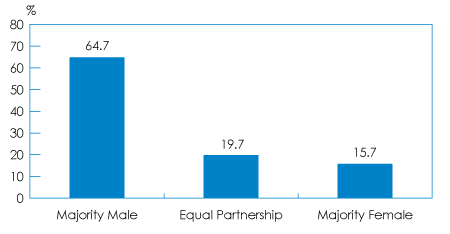
Note: Due to rounding, estimates may add up to more than 100 percent.
Sources: Statistics Canada, Survey on Financing and Growth of Small and Medium Enterprises, 2014; and Innovation, Science and Economic Development Canada calculations.
Figure 8.1-2 indicates that SMEs owned by females are concentrated in the service sector, most commonly in information, administration, health care and recreation; and other services (24.1 percent and 23.0 percent respectively). Construction and agriculture/primary have the lowest values for majority ownership by females (5.1 percent and 6.2 percent respectively). Agriculture/primary has the highest share of equal partnerships between male and female owners (32.6 percent). Wholesale trade and manufacturing have the same proportion of majority ownership by females (8.8 percent).
Figure 8.1-2: Business Ownership by Gender and Industries, 2014
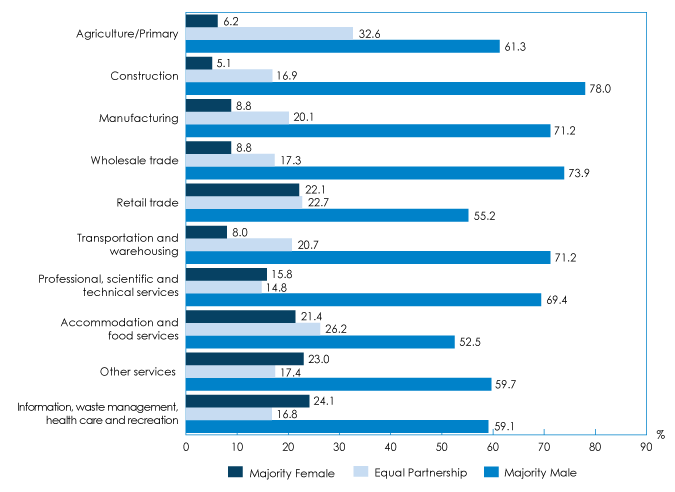
Source: Statistics Canada, Survey on Financing and Growth of Small and Medium Enterprises, 2014.
8.2 What are the age, experience and education levels of SME owners?
Figure 8.2-1 shows the age distribution of SME owners. The majority of small and medium-sized business owners are in the "40–49" and "50–64"years of age categories. These two age brackets comprise 73.5 percent of all small business owners and 78.3 percent of all medium-sized enterprise owners. The highest percentage of SME owners is in the "50–64" years of age group (47.4 percent for small businesses and 51.0 percent for medium-sized businesses). The percentage of medium-sized business owners is higher in all age categories except the "<30–39" years of age bracket, where small business ownership is 14.7 percent compared with 7.5 percent for medium-sized businesses.
Figure 8.2-1: Percentage of SME Owners by Age and Business Size, 2014
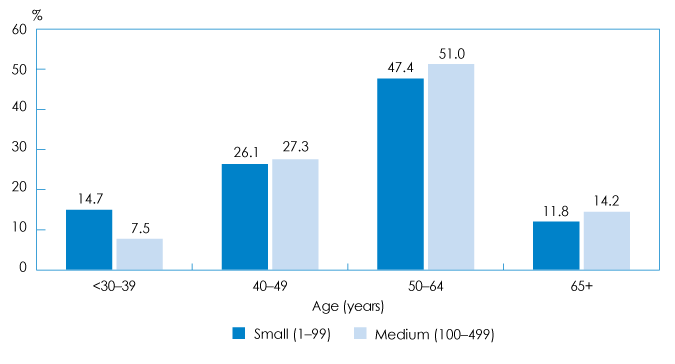
Sources: Statistics Canada, Survey on Financing and Growth of Small and Medium Enterprises, 2014; and Innovation, Science and Economic Development Canada calculations.
Figure 8.2-2 illustrates SME owners' years of experience managing or owning a business. In the "<5" and "5–10" years of experience categories, the percentage of small business owners is higher than the percentage of medium-sized enterprise owners. In the "10+" years of experience category, the opposite is true (83.4 percent ownership of medium-sized enterprises versus 74.9 percent ownership of small businesses and 75.0 percent ownership for all SMEs). The majority of small business owners are also concentrated within the "10+" years of experience range.
Figure 8.2-2: Percentage of SME Owners by Years of Experience and Business Size, 2014

Sources: Statistics Canada, Survey on Financing and Growth of Small and Medium Enterprises, 2014; and Innovation, Science and Economic Development Canada calculations.
Data on education levels of business owners is presented in Figure 8.2-3. More than 60 percent of medium-sized business owners have a bachelor's or a master's degree, compared with 38 percent of small business owners. Small business owners are concentrated in lower education attainment groups, with their highest representation in the "college, CEGEP or trade school diploma" category (30.8 percent).
Figure 8.2-3: Highest Level of Education Attained by SME Owners, 2014
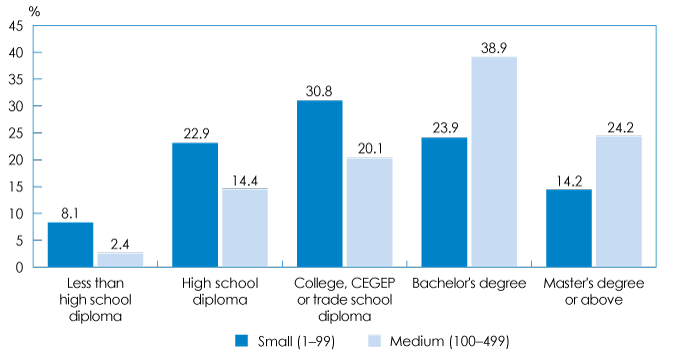
Sources: Statistics Canada, Survey on Financing and Growth of Small and Medium Enterprises, 2014; and Innovation, Science and Economic Development Canada calculations.
9. Concluding Remarks
This publication has summarized the main characteristics of SMEs in Canada, including the population of SMEs, their distribution and their growth performance and details on the characteristics of business owners. These metrics highlight the important role SMEs play in the national economy and provide statistical information for researchers and analysts.
